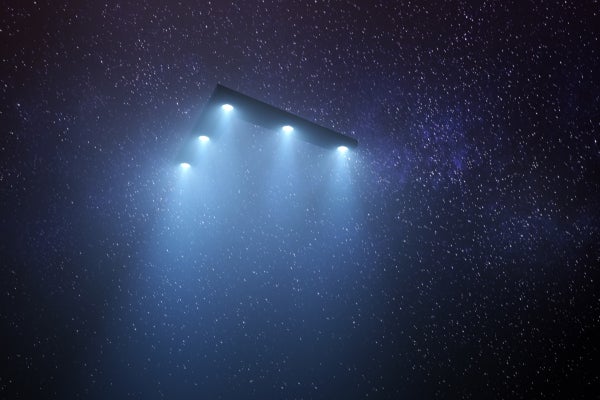In the courtroom, eyewitness testimony can lead to a life sentence in jail. But in science, such testimony is of limited value. Science mandates quantitative measurements by instruments, removing the subjective impressions of humans from the balance scale of reliability. This is for a good reason. Some people truly believe in a reality that does not exist, either because of hallucinations or as a consequence of deep psychological forces that drive them to ignore facts, especially those that are not flattering to their forecasts or ego.
Similarly, one-time events—miracles, for example—do not have scientific credibility. Science rests on reproducible results that can be replicated by creating similar circumstances over and over again.
The nature of credible scientific evidence is particularly critical in the context of unidentified flying objects (UFOs). Past reports constitute a mixed bag, containing eyewitness testimonies and low-quality instrumental data. In a recent interview about my book Extraterrestrial, a journalist referred to the astronomical discovery of the weird interstellar object ‘Oumuamua as if it were a UFO report.
On supporting science journalism
If you're enjoying this article, consider supporting our award-winning journalism by subscribing. By purchasing a subscription you are helping to ensure the future of impactful stories about the discoveries and ideas shaping our world today.
I clarified that the two are of very different natures, because the data on ‘Oumuamua was obtained through scientific observations on fully equipped state-of-the-art telescopes, whereas even the best UFO reports stem from a jittery camera on a fighter jet maneuvering along an unknown path. Such a report does not constitute a standard scientific measurement in a reproducible setup. Any supporting testimonies by pilots are vulnerable to the subjectivity inherent in human experiences. We must humbly recognize that a complete quantitative knowledge of the conditions in an experimental setup is a fundamental prerequisite for scientific data to be credible.
With this principle in mind, the Pentagon report that was delivered to Congress on June 25, 2021 is intriguing enough to motivate scientific inquiry towards the goal of identifying its unidentified aerial phenomena (UAP). But policy makers or military personnel have insufficient training in science and no authority over unexpected phenomena in the sky.
Rather than dismiss the Pentagon evidence as insufficient, scientists should be motivated to replicate it with better instruments. This is the rationale for the new Galileo Project that I initiated recently to scientifically explore the nature of UAP. The primary objective of this research endeavor is to bring the search for extraterrestrial technological signatures of extraterrestrial technological civilizations (ETCs) from accidental or anecdotal observations to the mainstream of transparent, validated and systematic scientific research.
The Galileo Project follows three major avenues of research. The first involves obtaining high-resolution images of UAP using an array of dedicated small-aperture telescope at various geographical locations. Extensive artificial intelligence/deep learning (AI/DL) and algorithmic approaches are needed to differentiate atmospheric phenomena from birds, balloons, commercial aircraft or drones, and from potential technological objects of terrestrial or other origin surveying our planet, such as satellites.
For the purpose of high-contrast imaging, each telescope will be part of a detector array of complementary capabilities from radar systems to optical and infrared cameras on telescopes. Parallax could also help to map the motion of objects in three dimensions. For example, two telescopes separated by three feet would see an object at a distance as large as 10 miles with a resolvable angular separation of ten arcseconds.
The second goal of the Galileo Project involvessearching for ‘Oumuamua-like interstellar objects. The project aims to utilize existing and future astronomical surveys, such as the Legacy Survey of Space and Time (LSST) on the Vera C. Rubin Observatory (VRO), to discover and monitor the properties of interstellar visitors to the solar system. The research team will conceptualize and design a launch-ready space mission to image unusual interstellar objects such as ‘Oumuamua by intercepting their trajectories on their approach to the sun or by using ground-based survey telescopes to discover interstellar meteors.
Finally, theGalileo Project will besearching for potential ETC satellites orbiting Earth. Discovering meter-scale or smaller satellites that may be exploring Earth, e.g., in polar orbits a few hundred kilometers above Earth, may become feasible with VRO in 2023, but if radar, optical and infrared technologies have been mastered by an ETC, then sophisticated telescopes on Earth will be required, with advanced algorithmic and AI/DL methods that the Galileo Project intends to develop and deploy, initially on non-orbiting telescopes.
As humans, we should be proud of any AI/DL systems we bring to existence, as if they were our children. In much the same way as we educate our kids, we could endow such systems with the blueprint for their future interaction with the world. This would include our preferred set of values, goals and guiding principles, which will enable them to learn from experience and cope with reality. Ultimately, we may launch our AI/DL systems for interstellar travel towards distant destinations, such as habitable planets around other stars, where they could reproduce themselves with the help of accompanying 3-D printers.
And if other technological civilizations predated us, they may have taken similar actions already. Even if the Galileo Project discovers just one such AI/DL system of extraterrestrial origin, that finding would have great implications for humanity. As is the case for AI/DL systems that learn from interactions with their environment, the scientific process of collecting evidence is key for a reliable revision of our own view of the world around us.
This is an opinion and analysis article; the views expressed by the author or authors are not necessarily those of Scientific American
